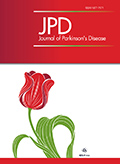Authors: Goubault, Etienne | Nguyen, Hung P. | Bogard, Sarah | Blanchet, Pierre J. | Bézard, Erwan | Vincent, Claude | Langlois, Mélanie | Duval, Christian
Article Type:
Research Article
Abstract:
Background: Clinical and anecdotal observations propose that patients with Parkinson’s disease (PD) may show drug-induced dyskinesia (DID) concomitantly with cardinal motor features. However, the extent of the concomitant presence of DID and cardinal features remains to be determined. Objectives: This cross-sectional study measured peak-dose choreic-type DID in a quantitative manner in patients diagnosed with PD, and determined whether symptoms such as tremor, bradykinesia, rigidity, postural instability or freezing of gait (FoG) were still detectable in these patients. Methods: 89 patients diagnosed with PD were recruited and assessed using a combination of quantitative measures using inertial measurement
…units to capture DID, tremor, bradykinesia, and FoG. Clinical evaluations were also used to assess rigidity and postural instability. Motor symptoms of PD were assessed 3 times during the testing period, and a series of activities of daily living were repeated twice, in between clinical tests, during which the level of DID was quantified. Peak-dose was identified as the period during which patients had the highest levels of DID. Levels of tremor, rigidity, bradykinesia, postural instability, and FoG were used to determine the percentage of patients showing these motor symptoms simultaneously with DID. Results: 72.4% of patients tested presented with measurable DID during the experiment. Rest, postural and kinetic tremor (12.7% , 38.1% , and 15.9% respectively), bradykinesia (28.6% ), rigidity (55.6% ), postural instability (71.4% ) and FoG (9.5% ) were detected simultaneously with DID. Conclusions: PD symptomatology remains present in patients showing peak-dose choreic-type DID, illustrating the challenge facing physicians when trying to avoid dyskinesia while attempting to alleviate motor symptoms.
Show more
Keywords: Chorea, drug-induced, dyskinesia, hypokinesia, movement disorders, Parkinson disease, tremor
DOI: 10.3233/JPD-181312
Citation: Journal of Parkinson's Disease,
vol. 8, no. 2, pp. 323-331, 2018






